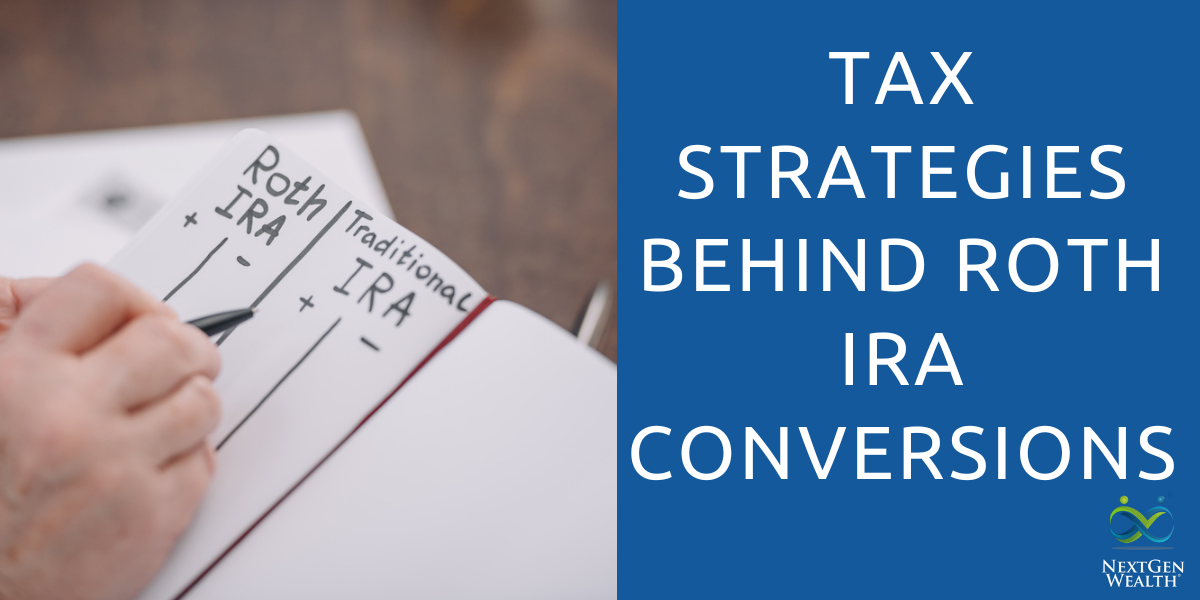Tax Strategies Behind Roth IRA Conversions
This post was last updated on January 03, 2025, to reflect all updated information and best serve your needs.
Saving money for retirement is critical, but when it comes to the types of accounts you have, it can start to get a little confusing. 
Individual retirement accounts (IRAs) are the most common options for those looking to save money, and there are two primary types - Roth and Traditional.
Assuming that you don’t want more of your money going to Uncle Sam, you may need to utilize various tax strategies. Specifically, we’re going to look at your options when converting a traditional IRA to a Roth.
Roth vs. traditional IRAs: A Primer
Before you can understand the various advantages (and potential pitfalls) of a Roth IRA conversion, you need to know the primary differences between the two accounts. Here is a brief overview.
Income Restrictions
There are no income restrictions to contribute to a traditional IRA. However, there are income restrictions on whether or not you can deduct the contributions from your taxes.
For Roth IRAs, however, you could potentially make too much money to contribute to one. In 2025, individuals making at least $150,000 (modified adjusted gross income, or MAGI) will start to have restrictions. Anyone making over $165,000 cannot contribute to a Roth directly. For couples, restrictions begin at $236,000 and phase out entirely at $246,000.
Distributions
Traditional IRAs are subject to required minimum distributions (RMDs). Most tax-sheltered retirement accounts have these, and they are calculated based on life expectancy. The rule used to be that anyone over age 70 1/2 had to start taking RMDs, but the law changed in 2019 and again in 2022. Now, individuals can wait until 73 (75 starting in 2033).
Roth IRAs are not subject to RMDs. The money in your account can continue to grow tax-free for as long as you live. This also means that you can pass the funds down to your heirs tax free too. However, there may be requirements for your spouse or other beneficiaries to withdraw the funds from the inherited Roth IRA.
Contribution Limits
Both IRA accounts limit the amount you can put in within a given tax year. In 2025, the maximum total is $7,000. However, if you’re over 50, you can add another $1,000 to “catch up” for retirement. Keep in mind that the total is across both kinds of accounts - you can’t do $7,000 per IRA. The total contribution between Roth and traditional IRAs is $7,000 ($8,000 with catch-up contributions).
Withdrawals
Again, traditional IRAs are designed to help you have money for retirement. Because of that, they will charge stiff penalties if you try to take any funds out before age 59 1/2. Typically, you will have to pay taxes on the income (more on that later), as well as a 10% penalty.
That being said, you can usually withdraw money from your IRA at a younger age for specific life events, such as buying a house or paying for medical bills. You will need to talk with your financial advisor to see if and when you qualify for these penalty-free withdrawals.
For Roth IRAs, any contributions you make can be taken out both tax-free and without penalty. Taxes and fees will only take effect on any earnings from the account. However, as with a traditional IRA, these penalties only happen if you’re younger than 59 1/2 or the account hasn't met the 5-year rule.
Tax Breaks
Depending on your particular situation, you can take advantage of the different tax rules between traditional and Roth IRAs. Let’s break down the primary difference between them before getting into the various tax strategies for a Roth conversion.
Traditional IRAs - Tax Deductible
When you put money away in a conventional IRA, you can deduct the funds from your modified adjusted gross income (MAGI) as long as you qualify. This means that your tax bill for any given year could be reduced. Those who are close to getting into a higher tax bracket can take advantage of this to ensure that they don’t owe more to the government.
When you withdraw funds from your IRA in retirement, you will be taxed at your current ordinary income rate. For many retirees, taxable earnings are substantially less in retirement, so you could end up with significant tax savings.
Roth IRAs - Tax-Free Withdrawals
Roth IRAs function in the opposite way of traditional IRAs. You contribute money after taxes are paid, then withdraw funds tax free.
In both cases, you won't pay taxes while your money is growing. However, you'll have to pay income taxes on withdrawals from a traditional IRA in retirement.
Why Convert to a Roth IRA?
As you can see, there is potentially a benefit to putting more of your money into a Roth IRA. Once you reach the required age, you can take all of your cash out without incurring taxes or fees. Not only that, but you can let your money grow longer, as there are no RMDs.
However, not everyone can take advantage of these accounts. Let’s look at a few scenarios to help you understand when to convert to a Roth and when it might be a bad move financially.
How Roth Conversions Work
There are three options when converting money from a traditional IRA to a Roth.
- 60-Day Rule - in this case, you withdraw money from your IRA via check, and then put it into a Roth IRA within 60 days. If you don’t, then you have to pay taxes on it and incur a penalty (assuming that you’re not 59 1/2).
- Trustee to Trustee - if you're using two financial institutions, have the one managing your traditional IRA rollover funds to the one handling your Roth.
- Same Trustee Transfer - for those who have both accounts with the same financial institution, you can convert funds much easier, as they don’t have to transfer from one place to another.
Paying Taxes On Your Conversion
When you convert to Roth, the conversion amount will be added to your total income for the year. You'll pay taxes when converting money into a Roth IRA, so you need to keep that in mind.
It's a good idea to pay for the cost of the conversion form funds outside of your retirement accounts. This allows you to keep more money in your retirement accounts to grow tax deferred (traditional) or tax-free (Roth).
Current vs. Future Tax Rates
Another reason to consider converting money to a Roth IRA account is that you believe that your tax rate will be higher in the future. Even in retirement, your earnings could be substantial, as the IRS considers income from a variety of sources. Some examples of non-career based earnings can include:
- Investment Income - if you have money in stocks and other investments, you will likely have to worry about capital gains.
- Rents and Royalties - owning a rental property ensures that you maintain passive income throughout retirement. This money is still part of your MAGI, though.
- Social Security - the government will start paying you once you file. This money is considered income by the IRS.
- Pensions and Annuities - pension plans offer guaranteed monthly income based on your earnings while you were working. Annuities can come from various sources, including life insurance policies.
- Inheritance - realistically, you will only have to worry about inheritance for a single tax year. However, if you get disbursements from a trust fund, that income can still be counted for tax purposes.
Overall, if you believe that your tax burden will be higher in retirement, then converting to a Roth now will make sense, provided that you have enough money to pay the government at the time of conversion.
Alternatively, if you think that your tax rate will be lower in retirement, it might be better to put money away in a traditional IRA instead. Depending on the difference between your tax rates, you could potentially save thousands of dollars in the long run.
Contact NextGen Wealth Today
Moving money between retirement accounts is relatively straightforward, provided that you do it correctly. In many cases, not knowing the rules or your total tax burden could put you in a bad situation. So, before attempting anything, be sure to speak to an expert.



